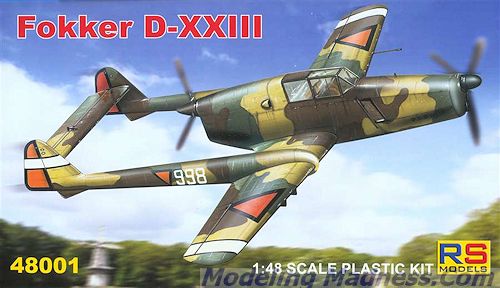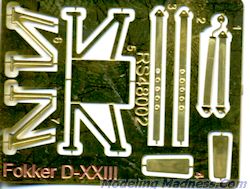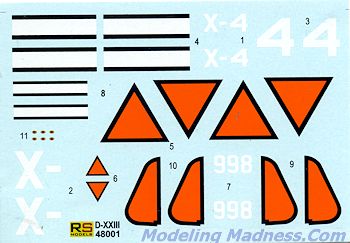
| KIT #: | 48001 |
| PRICE: | $68.95 SRP |
| DECALS: | Two options |
| REVIEWER: | Scott Van Aken |
| NOTES: | Short run with photo etch parts |

| HISTORY |
The Fokker D.XXIII was designed as a twin-engined single-seat aircraft. To overcome the problems of asymmetric flight it had a tractor engine at the front and a pusher engine at the rear. The D.XXIII was a cantilever monoplane with the twin tail units on booms. The pilot had an enclosed cockpit in between the tractor and pusher engines and it had a retractable tricycle landing gear.
The prototype first flew on 30 May 1939 powered by two Walter Sagitta I-SR liquid cooled vee piston engines. The trial flights identified problems with the cooling of the rear engine and general engine performance. It was proposed to use Rolls-Royce or Daimler-Benz engines in the production aircraft. Concerns were also raised about the pilot clearing the rear propeller if he had to bail out and an ejector seat was studied. The programme was abandoned in May 1940 when the German forces invaded the Netherlands. The lone prototype had flown a total of four hours in the year since its initial flight.
| THE KIT |
![]() Those
of you with better memories that most, will recall that RS Models produced this
kit in 1/72 scale a short while back. They chose this kit to begin their foray
into 1/48 scale and picked a rather neat subject for that. I can only assume
that their 1/72 kit sold well. The kit comes with two large sprues of grey
plastic with very nicely molded parts. There are not any rivets and what panel
line detail is there is crisply formed. You will find the several parts have
ejector towers on the inside of them and in some cases, these will need to be
removed to get the parts to fit properly.
Those
of you with better memories that most, will recall that RS Models produced this
kit in 1/72 scale a short while back. They chose this kit to begin their foray
into 1/48 scale and picked a rather neat subject for that. I can only assume
that their 1/72 kit sold well. The kit comes with two large sprues of grey
plastic with very nicely molded parts. There are not any rivets and what panel
line detail is there is crisply formed. You will find the several parts have
ejector towers on the inside of them and in some cases, these will need to be
removed to get the parts to fit properly.
 A photo etch
fret is included that is mercifully brief. It contains parts for the seat
harness and for the roll over bar assembly behind the pilot which contains some
sort of gizmo that I couldn't identify. The clear sprue includes a single-piece
canopy and six formation lights for the fins.
A photo etch
fret is included that is mercifully brief. It contains parts for the seat
harness and for the roll over bar assembly behind the pilot which contains some
sort of gizmo that I couldn't identify. The clear sprue includes a single-piece
canopy and six formation lights for the fins.
The cockpit is well appointed with the usual bits such as seat, control column, rudder pedals and instrument panels. These panels have raised detail. A decal would have been nice, but one will just have to paint it. This all fits atop the nose gear well piece. Sidewalls are included and have some detail to add to them, such as the throttle quadrant. One will need to install the exhaust stubs prior to closing the fuselage halves. There is a section of inverted vee engine to place behind the forward cowoling piece which will eat up some of the room you'll need for nose weight as I can see this being a major tail sitter. No indication of how much weight is needed is provided.
Wings consist of a one-piece lower section and two upper halves. Main gear wells are molded into the lower wing. Aileron control rods are provided. None of the control surfaces are separate. There are ledges on the back of the boom roots on the wings over which the tail booms will be placed. The horizontal stabilizer is two halves and also has a control rod piece. The kit includes two piece main wheels, the struts and all the various retraction struts needed as well as gear door struts.
Nose gear has a split fork into which one plces the
nose wheel. Nose wheel is also in two pieces. There are some little bits that
stick down from the lower wing which could be shell ejector chutes, but with
only one gun per wing it seems odd that these are there. The two props each have
d ifferent
spinners with the rear one being much more pointed as on the Do-335.
ifferent
spinners with the rear one being much more pointed as on the Do-335.
Instructions are well drawn and provide generic color references. It also includes some detail drawings, particularly helpful when it comes the landing gear as the main wheels are quite toed in. Markings are for the single prototype in two stages of its life. Both have the same camouflage scheme and just differ in markings. The full color painting and marking guide provide FS 595 color references, though I don't think there are any premixed paints with these shades. The decals are quite nicely done and in register. I'm sure most will choose the box art plane as it is very much more colorful.
| CONCLUSIONS |
If, like many of us, you have had your fill of P-51s, Bf-109s or A6Ms, then you should seriously consider something like this for your next build.
| REFERENCES |
http://en.wikipedia.org/wiki/Fokker_D.XXIII
August 2014
My thanks to, well, me for providing this kit and getting it on sale.
If you would like your product reviewed fairly and fairly quickly, please contact the editor or see other details in the Note to Contributors.